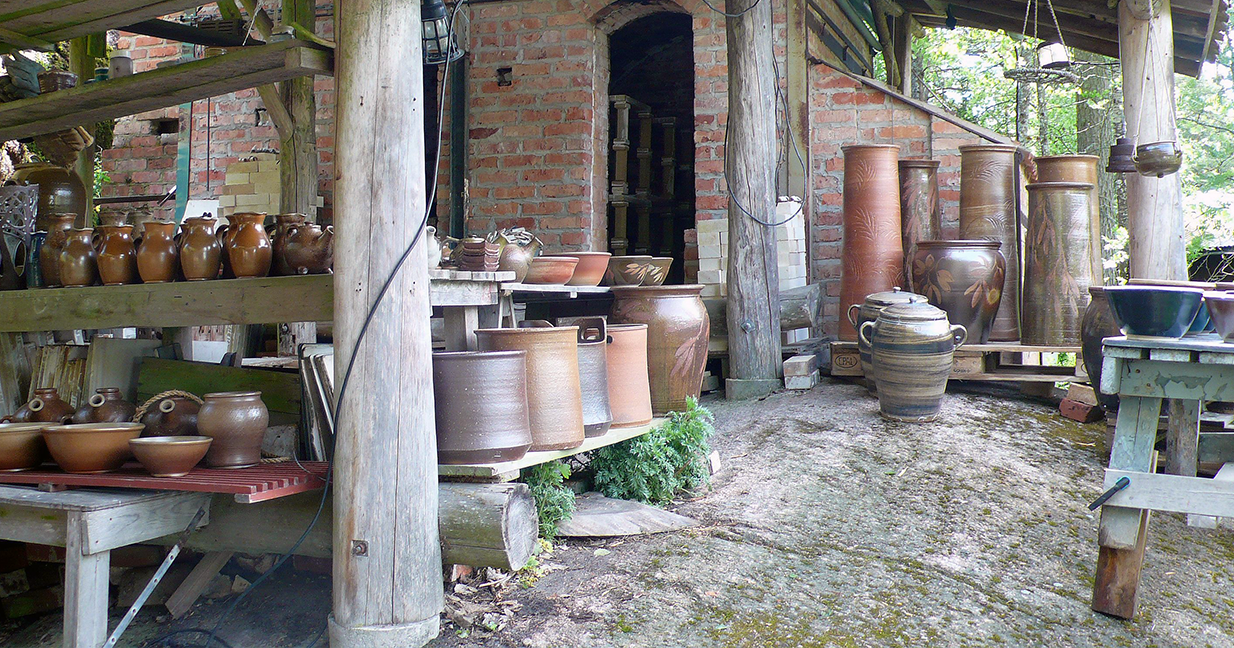About me
 I was born in 1954 in Helsinki. Before I started to work as a potter I have been studying philosophy and litterature, been a member of the swedish experimental theatergroup Institutet för Scenkonst and worked with handicapped people and in a mental hospital. I am politically active in the Green party and a member of our towncouncil here in Pargas. I am also a teacher in ceramics and a member of our local guild of ceramists.
I was born in 1954 in Helsinki. Before I started to work as a potter I have been studying philosophy and litterature, been a member of the swedish experimental theatergroup Institutet för Scenkonst and worked with handicapped people and in a mental hospital. I am politically active in the Green party and a member of our towncouncil here in Pargas. I am also a teacher in ceramics and a member of our local guild of ceramists.
I started working with ceramics in the 80ies. My main interest lies in woodfired stoneware pottery. In my work I try to be as selfsuficient as possible, blending part of my clays myself, mixing my own glazes from local materials and chopping the wood for the kilns one year in advance. That makes a lot of work, but brings me nearer to the process itself.
A potters philosophy
My work as a potter does not only consist in producing and selling pottery. Through my work I place myself in a tradition that, as a matter of fact, reaches back to the stone age. Throwing, glazing and firing pottery means that I participate and continue an ancient human activity. This appears also in the forms of my pottery: the technique of throwing and our cultural heritage contributes to forms that have been ours for such a long time that we comprehend them as timeless. It is also not my intention to change things that function well and that I find beautiful.
In spite of that, I think there is no risk of my work becoming monotonous or lacking in creativity. This is, as I see it, more the characteristic of industrial production. One of the main differences between industrial production and handicraft lies in the necessity of control: an industrially produced item should be exactly the same as all the other items in the series and it should be exchangeable with any other. More important, the product schould completely correspond to the idea of its designer and be foreseeable to a 100 per cent. This demand of control, even if it is comprehensible, is in my opinion ethically questionable as it is based on an intolerant attitude towards reality and the diversity of nature and life. No wonder that massproduced ware seems lifeless and in the last end, constitutes an environmental problem.
Within genuine handicraft on the other hand, the product should be seen as a kind of ansver to a dialogue between the material, the technique and the craftsman. As a potter for instance, you can never force your ideas onto the material, but a successful piece is in general the result of experience, a sensibility towards your material and the technique used. In such a product the material and the technique are shown in a balanced way thus leaving to the pot the possibility of telling the story of its creation. This ”opening” of a possibility is nothing you can control, but something you ask for, something that gives the piece a life of its own, something that makes it unique. Like a pebble on the beach or a tree in the forest speaks to us through their pure existence, a handmade pot speaks to us through its form, its material and its surface. Who listens to such a story understands also how it comes that some objects can age and in time, become even more beautiful.
We live in a world of an ever accelerating mass production of things. This forces us potters to consider the meaning of our work also from this point of view. How do we produce pots that have a right to exist in this world and do not contribute to the mass of dead manmade items submerging it? Within my work, I try to answer to this question.

Exhibitions (own and group-)
 1993 Pargas, Gamla Kommunalstugan
1993 Pargas, Gamla Kommunalstugan
1999 Pargas, Gamla Kommunalstugan
2000 Pargas, Gamla Kommunalstugan
2000 Åbo, Kuvataidekoulun Galeria
2001 Pargas, Gamla Kommunalstugan
2004 Pargas, Gamla Kommunalstugan
2005 Russia, Velikij Novgorod
2005 Åbo, Brinkkala Galleri
2006 Russia, Velikij Novgorod
2006 Denmark, Boerglum Kloster
2007 Helsingfors, Galleri Oljemark
2008 Fiskars, ”Tulessa Syntynyt”
2008 Nådendahl, Kulturhuset
2008 Russia, Komi, ”Zarnij Kyas”
2008-2009 Helsingfors, Galleri Bengelsdorff
2009 Åbo, Brinkkala Galleri
2009 Pargas Gamla Kommunalstugan
2010 Åbo, Galleri Campus
2011 Korpo, Korpoström
2011 Hauho, Hovikartano
2012 Valkeakoski, Voipaala, ”CERAMEGA”
2013 Pargas, Gamla Kommunalstugan
2015 Pargas, Gamla Kommunalstugan
